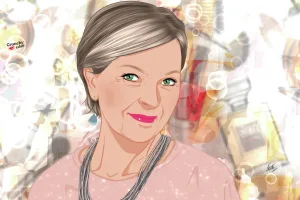Prof Carolyn Mair: “Great Style Starts With You”
There are some women whose backgrounds, styles and grace are so impressive that meeting them is like opening up new horizons. Prof Carolyn Mair is one such remarkable individual.
A trailblazing cognitive psychologist and Chartered Fellow of the British Psychological Society (BPS). Carolyn has made waves as a pioneering force behind the integration of psychology with the fashion industry. Her bestselling book, The Psychology of Fashion, has captivated more than 10,000 readers in six different languages.
But that’s not all. As a full Professor of Psychology for Fashion at the London College of Fashion, University of the Arts London, Carolyn didn’t just establish the university’s Psychology Department; she also created the world’s first MSc and BSc programs that brilliantly blend psychology with fashion. Her groundbreaking contributions have earned her prestigious awards, including the BPS’s Distinguished Contributions to Psychology Education Award and the UK’s Most Innovative Accredited Psychology Programme Award in 2016.
With a PhD in Cognitive Neuroscience, an MSc in Research Methods, and a BSc (Hons) in Applied Psychology and Computing, Carolyn’s expertise is both impressive and deeply impactful.
Get ready to be inspired by her journey and insights.
Carolyn, as we get older, it’s tough to reinvent ourselves, especially in terms of fashion. What’s the biggest hurdle?
Finding our identity is challenging at any age. As teens, we experiment with fashion to discover ourselves. Later, careers and roles shape our identities, including how we dress. When we retire or face life changes like children leaving home or health issues, that identity can feel lost. Our bodies change, and this affects self-esteem, which is closely tied to how we think others perceive us. You know, we belong to various groups and roles in life, and style can help us fit in and adapt. However, when we’re not represented in fashion, it can feel like we have no place. Fashion needs to be more inclusive to help us navigate our identity.
How can we ditch the idea of “age-appropriate” dressing?
Age-appropriate is outdated! It’s about context and lifestyle. If you’re engaged with life and mix with different people, the term becomes irrelevant. Focus on “context-appropriate” dressing instead. For example, a teenager might get away with wearing ripped jeans to a fancy event, but as we get older, it’s important to suit the context. When you’re unsure about what to wear to an event, do your homework to find out what’s appropriate. You don’t want to look like everyone else, but you also don’t want to feel uncomfortable.
Great point! So, how can women who feel invisible reclaim power through fashion?
Confidence comes from within. A power suit won’t help if you don’t feel confident. Focus on your strengths, values, and contributions. Choose clothes that reflect who you are and make you feel good. If you’re not feeling confident and have low self-esteem, fashion alone won’t help. Build confidence by being kind, respectful, generous, and contributing positively to the world. Once you boost your self-esteem, then you can choose clothes that emphasize your personality.
What about feeling less “sexy” as we age? Many women struggle with not having that “man gaze” on them anymore.
It’s a real issue, especially for those who identified with their attractiveness when younger. Physical signs of ageing can impact self-esteem. The more beautiful and attractive you were when younger, the harder it is to lose that part of your identity. Being sexy is linked to evolutionary psychology and attractiveness, often tied to childbearing age. However, if you have a partner who loves you, they’ll find you sexy regardless of age. But sooner or later, we all need to come to terms with that. Let’s embrace our attractiveness from within and focus on what makes us feel good.
So, what about the power of colours? Should we experiment with bold colours as we age?
Colour is about personal preference, not just brightness. Dopamine, the feel-good chemical, is released when you feel rewarded. Finding clothes that make you feel better triggers dopamine. Colors themselves don’t have inherent power – it’s the cultural associations we have with them. If we believe a certain colour makes us happy, it becomes part of our identity. For instance, wearing yellow can make you feel happier if you associate it with joy. My go-to colour is black because it gives me my dopamine hit. It’s all about the stories we associate with our clothes.
Last question. Your book has sold more than 10,000 copies. Can you summarize the key takeaways?
Self-care, self-respect, and self-value are crucial. Reaching a sense of self that we’re happy with might be challenging, but before reassessing our wardrobe, we need to start with ourselves and recognize our value. What do we contribute? What are our strengths? We all have something to contribute. Once we understand this, we can rearrange our wardrobe to amplify our positive sense of self. When we feel better, we look better. Clothing is an accessory to our sense of self. Keeping physically fit is good for the mind, body, and longevity. Staying interested in what’s going on, engaging with different age groups and maintaining a “can-do” attitude help us stay relevant.
Like this post? Support Us or Sign up to our newsletter to get more articles like this delivered straight to your inbox!





